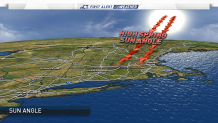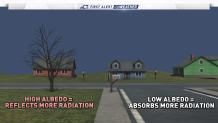
Most of the state saw steady snow for hours yesterday and you might have noticed how much quicker the snow accumulated on the grass than on asphalt.
The struggle to get accumulating snow on roads, sidewalks, driveways, etc. in March all comes down to the sun angle and its influence on the earths surface.
During the winter months the sun angle is very low and very little radiation is being produced by the sun. Combine that with the shorter daylight hours and snow accumulates much quicker on the colder surfaces. As we head through the spring months, the sun gets higher and higher in the sky. As the sun angle gets higher, it produces more radiation (even on cloudy days!) which warms the surface. We also have more hours of daylight, so it becomes increasingly difficult for snow to accumulate.

However, not all surfaces are created equally, and different surfaces absorb or reflect radiation differently. We call this albedo!
Lighter colored surfaces have higher albedo, which gives off a higher reflectivity so the radiation bounces off light surfaces more readily. Darker colors on the other hand have a lower albedo and absorb radiation. When the radiation gets absorbed, the surfaces warm. That’s why surfaces like grass accumulate snow more easily than roadways, sidewalks and driveways.

You can test it out at home!
Materials needed:
- 2 baking sheets
- A hairdryer
- A cup of “snow” (blend ice with a little water)
Instructions:
- Place one of your baking sheets in the freezer to cool it (this represents colder asphalt in the winter)
- Heat the other baking sheet with your hairdryer (this represents the warmer asphalt in the spring)
- Make it snow! Place some of the manmade snow on the warm baking sheet and watch it melt quickly
- Take the other baking sheet out of the freezer and watch the “snow” stay in tact as it would accumulate in the winter

